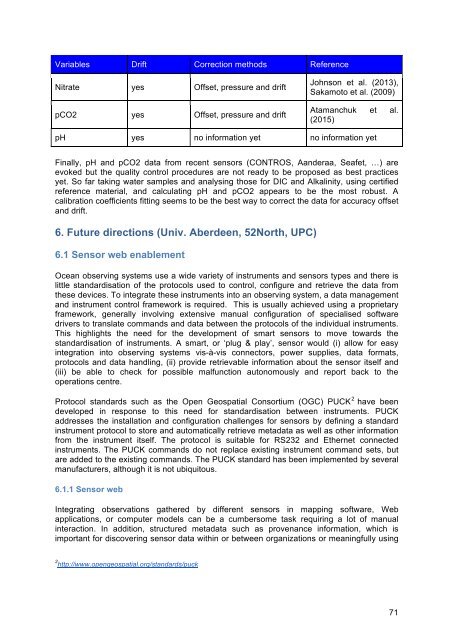Handbook of best practices
Handbook%20of%20best%20practices
Handbook%20of%20best%20practices
You also want an ePaper? Increase the reach of your titles
YUMPU automatically turns print PDFs into web optimized ePapers that Google loves.
Variables Drift Correction methods Reference<br />
Nitrate yes Offset, pressure and drift<br />
pCO2 yes Offset, pressure and drift<br />
Johnson et al. (2013),<br />
Sakamoto et al. (2009)<br />
Atamanchuk et al.<br />
(2015)<br />
pH yes no information yet no information yet<br />
Finally, pH and pCO2 data from recent sensors (CONTROS, Aanderaa, Seafet, …) are<br />
evoked but the quality control procedures are not ready to be proposed as <strong>best</strong> <strong>practices</strong><br />
yet. So far taking water samples and analysing those for DIC and Alkalinity, using certified<br />
reference material, and calculating pH and pCO2 appears to be the most robust. A<br />
calibration coefficients fitting seems to be the <strong>best</strong> way to correct the data for accuracy <strong>of</strong>fset<br />
and drift.<br />
6. Future directions (Univ. Aberdeen, 52North, UPC)<br />
6.1 Sensor web enablement<br />
Ocean observing systems use a wide variety <strong>of</strong> instruments and sensors types and there is<br />
little standardisation <strong>of</strong> the protocols used to control, configure and retrieve the data from<br />
these devices. To integrate these instruments into an observing system, a data management<br />
and instrument control framework is required. This is usually achieved using a proprietary<br />
framework, generally involving extensive manual configuration <strong>of</strong> specialised s<strong>of</strong>tware<br />
drivers to translate commands and data between the protocols <strong>of</strong> the individual instruments.<br />
This highlights the need for the development <strong>of</strong> smart sensors to move towards the<br />
standardisation <strong>of</strong> instruments. A smart, or ‘plug & play’, sensor would (i) allow for easy<br />
integration into observing systems vis-à-vis connectors, power supplies, data formats,<br />
protocols and data handling, (ii) provide retrievable information about the sensor itself and<br />
(iii) be able to check for possible malfunction autonomously and report back to the<br />
operations centre.<br />
Protocol standards such as the Open Geospatial Consortium (OGC) PUCK 2 have been<br />
developed in response to this need for standardisation between instruments. PUCK<br />
addresses the installation and configuration challenges for sensors by defining a standard<br />
instrument protocol to store and automatically retrieve metadata as well as other information<br />
from the instrument itself. The protocol is suitable for RS232 and Ethernet connected<br />
instruments. The PUCK commands do not replace existing instrument command sets, but<br />
are added to the existing commands. The PUCK standard has been implemented by several<br />
manufacturers, although it is not ubiquitous.<br />
6.1.1 Sensor web<br />
Integrating observations gathered by different sensors in mapping s<strong>of</strong>tware, Web<br />
applications, or computer models can be a cumbersome task requiring a lot <strong>of</strong> manual<br />
interaction. In addition, structured metadata such as provenance information, which is<br />
important for discovering sensor data within or between organizations or meaningfully using<br />
2 http://www.opengeospatial.org/standards/puck<br />
71


